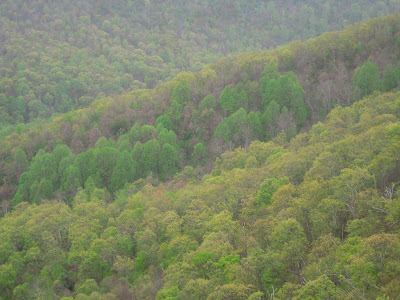 Logistically, the Shenandoahs are an odd place to hike. They are a long, thin range, with few outlying peaks, and Skyline Drive cuts along near the crest of the ridge for its entire length. Thus it is difficult to avoid encounters with the automobile when climbing any of the taller peaks. Just last weekend, my hiking partner Paul Singh and I emerged from the Bluff Trail onto a dirt road to a find a couple (mother clad in fur) wheeling a stroller. Not far beyond, we arrived at a parking lot where the trail (now part of the AT) crosses the Drive. A license plate read “1derer.”
Logistically, the Shenandoahs are an odd place to hike. They are a long, thin range, with few outlying peaks, and Skyline Drive cuts along near the crest of the ridge for its entire length. Thus it is difficult to avoid encounters with the automobile when climbing any of the taller peaks. Just last weekend, my hiking partner Paul Singh and I emerged from the Bluff Trail onto a dirt road to a find a couple (mother clad in fur) wheeling a stroller. Not far beyond, we arrived at a parking lot where the trail (now part of the AT) crosses the Drive. A license plate read “1derer.”With the exception of a jaunt up Old Rag, about which word is definitely out, I haven’t encountered many people on trails of the Shenandoahs this spring, even along the AT near the crest of the ridge. Though it is considerably closer to DC than the Whites are to Boston, its perceptual distance seems to be substantial to most Washingtonians. The ranger at the Drive’s gate was quintessentially Park Service chipper about “Wildflower Weekend,” but traffic was light on the road itself. Apparently fall is peak season.
 Skyline Drive is here to stay. Built in the thirties, originally under the WPA and with help from the CCC, it is a National Historic Landmark. Entrance costs fifteen dollars, and as two of the park’s four campground were closed last weekend, the park can probably use every penny of the revenue. On the other hand, the 40% of the park that is wilderness is literally all on the mountainsides; the ridge is very much trammeled by man.
Skyline Drive is here to stay. Built in the thirties, originally under the WPA and with help from the CCC, it is a National Historic Landmark. Entrance costs fifteen dollars, and as two of the park’s four campground were closed last weekend, the park can probably use every penny of the revenue. On the other hand, the 40% of the park that is wilderness is literally all on the mountainsides; the ridge is very much trammeled by man. In New Hampshire, the closest parallel
 is probably the Mount Washington Auto Road, though its impact is proportionally far smaller given the size of the Whites. In the thirties, a road to run along the spine of the Presidentials was proposed. Potential construction and maintenance costs were vast, however (alpine freeze-thaw cycles are unkind to asphalt), and the plans were scrapped.
is probably the Mount Washington Auto Road, though its impact is proportionally far smaller given the size of the Whites. In the thirties, a road to run along the spine of the Presidentials was proposed. Potential construction and maintenance costs were vast, however (alpine freeze-thaw cycles are unkind to asphalt), and the plans were scrapped.For the casual hiker, Skyline Drive does present an interesting ethical quandary. Should one condemn the road as a biological and geographical intrusion and forgo its offer to relieve tiresome hikes up to the ridge or accept its permanence and embrace the enhanced access?
Last weekend, Paul and I did use the road and had the unusual experience of starting our hike in descent. In fact, our midpoint, a gorge called The Devil’s Stairs, is only served by a trail descending from above that ends at the park boundary. The return across the ridge was mostly in emerald woods, with a few rocky outcrops interspersed. The AT crossed the road several times, giving the hike a rural rather than wild flavor.




